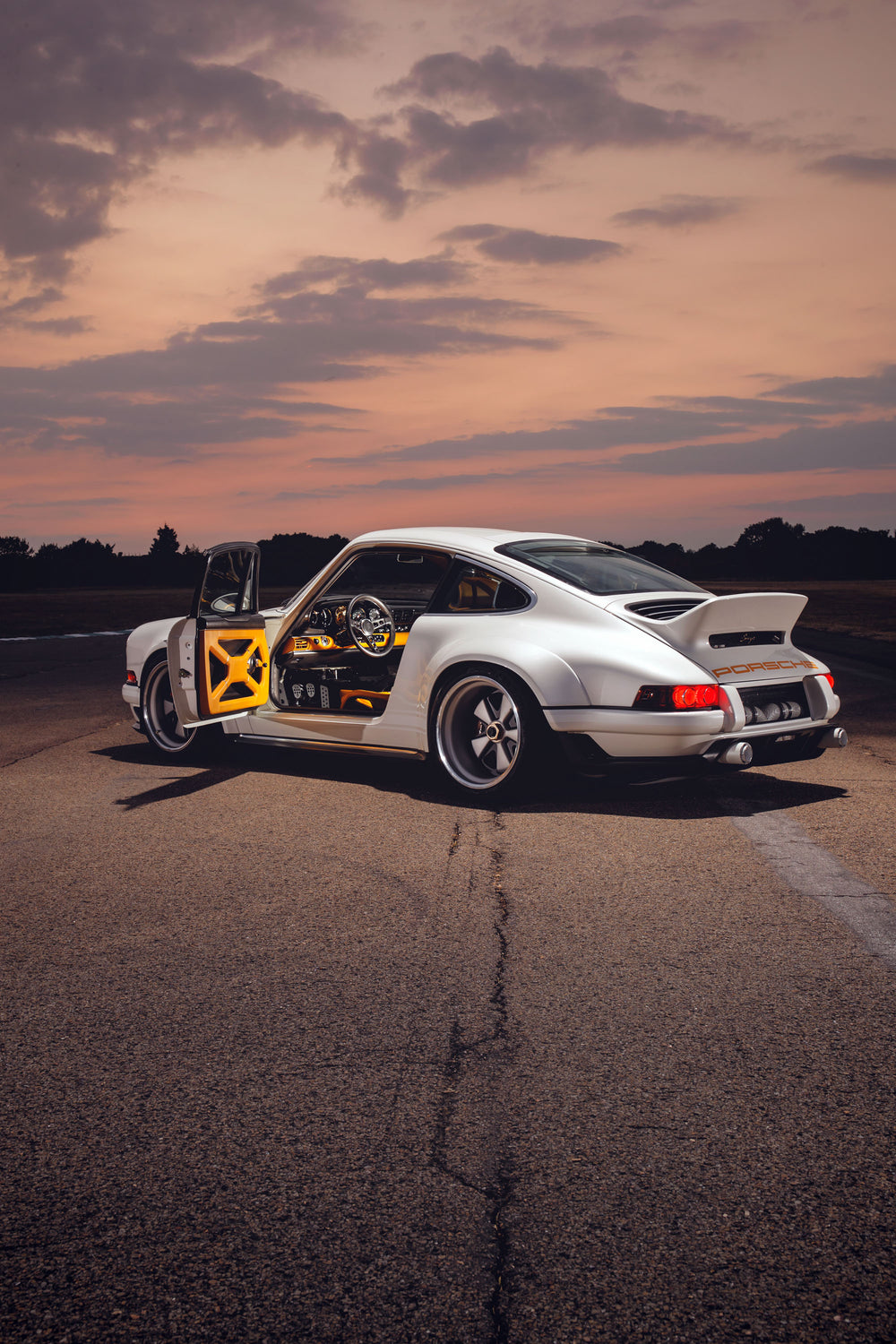




You probably saw the renders of the Absinthe Green one late last year after the company's partnership with Williams was announced, but the car shown here in Parallax White also exists outside of a hard drive, and will be debuted in the carbon and in action at the 2018 edition of the Goodwood Festival of Speed, which begins today. The car is one of just 75 that will ever exist, and it is the result of Singer working in cooperation over the past three years with a stacked team of engineers and other pioneering minds in the industry of making cars go fast on diets. Williams Advanced Engineering was the most integral new partner on the project though, with the experienced Oxfordshire-based team working on major components like engine development (where they teamed up with Hans Mezger of factory Porsche engine fame to produce new four-valve heads and lightweight magnesium components among other things like reengineering the oiling system to find 500hp and 9,000RPM inside the enlarged-capacity 4.0L flat-six) and on the other side of the skin, aerodynamics.









Every panel on the 911s to be restored under the guidelines of the DLS will be made from carbon fiber, and every panel has been modified from its standard shape. Most obvious is the set of extended rear flares, but the wildest exterior treatments in the list of improvements made by Williams and Norbert Singer are the roof-channel and the beautiful scoops integrated into the quarter windows. The latter is to keep the air-cooled engine fed with enough atmosphere, while the former work in conjunction with the redesigned ducktail-style wing on the engine cover.






The entirety of the exterior surface was reshaped with the aid of computational fluid dynamics. I don't know what that means either, but I trust that there's plenty of math backing up the curves and cuts. I do know that it looks like nothing else, even if no design elements are groundbreaking on their own. It seems like every combination of headlight bezel and bumper cover have been done on modified 911s, but those modified by Singer using the DLS playbook strike a unique balance between modern and vintage. The grille mesh intakes and the rear spoiler call on the '70s street car look and the arched flares add a bit of motorsport style from the same era, while the larger-diameter wheels and LED lighting equipment give it a contemporary touch without the heavy hand that ruins so many builds that aim for old school and end up on the short bus headed in the opposite direction toward a misguided modern version. The general impact, the overall first impression, is that of a very well-done hot-rodded backdated 911, but being a car modified by Singer means the level of fit and finish elevate the car to a plane occupied by very few.




The interior on the car shown here for example, a 1990 964, is a very unfussy mix of function and form—maybe a bit loud for some tastes when it comes to color, the layout and shapes and materials used to recreate the 911 cockpit achieve the feat of looking supercar sexy without trying too hard. There are intake tubes and a small jungle gym's worth of torsional enhancement equipment competing for a relatively small volume of space dominated by two big bucket seats, but even with the deeply saturated Norfolk Yellow playing off the shine of the polished carbon fiber accoutrements it doesn't look like anything is in the way of anything else and it's hard to guess which elements concede to the others and vice versa. It looks like a whole.




The wrapping paper of cars modified by Singer has always been the most noticeable separator between their work and the rest's, but when a 911 leaves their care it will be able to do so at a much greater pace than when it arrived because they don't just put 911s through pageant regiments at Singer. The cars that will be restored in accordance with the DLS components and knowledge will be the most dynamic and potent yet from the company whose restorations in the past have included engines reworked by the great Ed Pink. When it comes to the DLS package and the 4.0L developed by Williams that powers it,we've already touched on most of the performance pieces developed during the study when the first official details were announced last fall, but to repeat, the gist is this: Singer partnered with the experts in the field on each component.









Wheels are single pieces of magnesium forged by BBS for the DLS needs specifically, the brakes are a similar story with Brembo, as are the tires with Michelin. Bosch made a bespoke management system for the DLS, Recaro worked with Singer on optimizing the seats, the dampers are from Williams Advanced Engineering and are "mass-optimized," and the weight distribution has also been optimized thanks to relocating some gear and sliding the engine forward a few cm. "Optimized" seems to be the key word of the press release, and though its definition has worn thin over the years of PR employment, it does seem to be an apt one to describe what we'll soon be seeing on the hill at Goodwood.
500 naturally-aspirated, air-cooled horsepower pushing along a jeweler's idea of carbon bodywork; not bad for a souped up 911. If you miss your chance to see it in person in the UK this weekend, cars from the DLS will also be appearing in Monterey during Car Week beginning on August 23rd.





















































